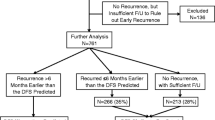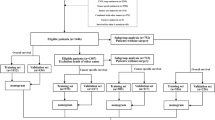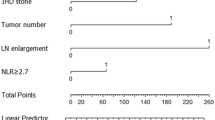Abstract
Background
Accurate risk stratification and patient selection is necessary to identify patients who will benefit the most from surgery or be better treated with other non-surgical treatment strategies. We sought to identify which patients in the preoperative setting would likely derive the most or least benefit from resection of intrahepatic cholangiocarcinoma (ICC).
Methods
Patients who underwent curative-intent resection for ICC between 1990 and 2017 were identified from an international multi-institutional database. A machine-based classification and regression tree (CART) was used to generate homogeneous groups of patients relative to overall survival (OS) based on preoperative factors.
Results
Among 1146 patients, CART analysis revealed tumor number and size, albumin-bilirubin (ALBI) grade and preoperative lymph node (LN) status as the strongest prognostic factors associated with OS among patients undergoing resection for ICC. In turn, four groups of patients with distinct outcomes were generated through machine learning: Group 1 (n = 228): single ICC, size ≤ 5 cm, ALBI grade I, negative preoperative LN status; Group 2 (n = 708): (1) single tumor > 5 cm, (2) single tumor ≤ 5 cm, ALBI grade 2/3, and (3) single tumor ≤ 5 cm, ALBI grade 1, metastatic/suspicious LNs; Group 3 (n = 150): 2–3 tumors; Group 4 (n = 60): ≥ 4 tumors. 5-year OS among Group 1, 2, 3, and 4 patients was 60.5%, 35.8%, 27.5%, and 3.8%, respectively (p < 0.001). Similarly, 5-year disease-free survival (DFS) among Group 1, 2, 3, and 4 patients was 47%, 27.2%, 6.8%, and 0%, respectively (p < 0.001).
Conclusions
The machine-based CART model identified distinct prognostic groups of patients with distinct outcomes based on preoperative factors. Survival decision trees may be useful as guides in preoperative patient selection and risk stratification.


Similar content being viewed by others
References
Wu L, Tsilimigras DI, Paredes AZ, et al. Trends in the incidence, treatment and outcomes of patients with intrahepatic cholangiocarcinoma in the USA: facility type is associated with margin status, use of lymphadenectomy and overall survival. World J Surg. 2019; 43:1777–87.
Singal AK, Vauthey JN, Grady JJ, Stroehlein JR. Intra-hepatic cholangiocarcinoma–frequency and demographic patterns: thirty-year data from the M.D. Anderson Cancer Center. J Cancer Res Clin Oncol. 2011;137(7):1071–8.
de Jong MC, Nathan H, Sotiropoulos GC, et al. Intrahepatic cholangiocarcinoma: an international multi-institutional analysis of prognostic factors and lymph node assessment. J Clin Oncol. 2011;29(23):3140–5.
Endo I, Gonen M, Yopp AC, et al. Intrahepatic cholangiocarcinoma: rising frequency, improved survival, and determinants of outcome after resection. Ann Surg. 2008;248(1):84–96.
Merath K, Chen Q, Bagante F, et al. A Multi-institutional International Analysis of Textbook Outcomes Among Patients Undergoing Curative-Intent Resection of Intrahepatic Cholangiocarcinoma. JAMA Surg. 2019;154(6):e190571.
Zhang XF, Beal EW, Bagante F, et al. Early versus late recurrence of intrahepatic cholangiocarcinoma after resection with curative intent. Br J Surg. 2018;105(7):848–56.
Yadav S, Xie H, Bin-Riaz I, et al. Neoadjuvant vs. adjuvant chemotherapy for cholangiocarcinoma: a propensity score matched analysis. Eur J Surg Oncol. 2019;45(8):1432–8.
Buettner S, Galjart B, van Vugt JLA, et al. Performance of prognostic scores and staging systems in predicting long-term survival outcomes after surgery for intrahepatic cholangiocarcinoma. J Surg Oncol. 2017;116(8):1085–95.
Hyder O, Marques H, Pulitano C, et al. A nomogram to predict long-term survival after resection for intrahepatic cholangiocarcinoma: an Eastern and Western experience. JAMA Surg. 2014;149(5):432–8.
Wang Y, Li J, Xia Y, et al. Prognostic nomogram for intrahepatic cholangiocarcinoma after partial hepatectomy. Journal of clinical oncology: official journal of the American Society of Clinical Oncology. 2013;31(9):1188–95.
Sasaki K, Margonis GA, Andreatos N, et al. Preoperative Risk Score and Prediction of Long-Term Outcomes after Hepatectomy for Intrahepatic Cholangiocarcinoma. J Am Coll Surg. 2018;226(4):393–403.
Tsilimigras DI, Hyer JM, Moris D, et al. Prognostic utility of albumin-bilirubin grade for short- and long-term outcomes following hepatic resection for intrahepatic cholangiocarcinoma: a multi-institutional analysis of 706 patients. J Surg Oncol. 2019;120(2):206–213.
Moro A, Paredes AZ, Farooq A, et al. Discordance in prediction of prognosis among patients with intrahepatic cholangiocarcinoma: a preoperative vs postoperative perspective. J Surg Oncol. 2019;120(6):946–955.
Bagante F, Spolverato G, Merath K, et al. Intrahepatic cholangiocarcinoma tumor burden: a classification and regression tree model to define prognostic groups after resection. Surgery. 2019. https://doi.org/10.1016/j.surg.2019.06.005.
Wiener M, Acland KM, Shaw HM, et al. Sentinel node positive melanoma patients: prediction and prognostic significance of nonsentinel node metastases and development of a survival tree model. Ann Surg Oncol. 2010;17(8):1995–2005.
Amin MB, Greene FL, Edge SB, et al. The Eighth Edition AJCC Cancer Staging Manual: Continuing to build a bridge from a population-based to a more “personalized” approach to cancer staging. CA Cancer J Clin. 2017;67(2):93–9
Strasberg SM. Nomenclature of hepatic anatomy and resections: a review of the Brisbane 2000 system. J Hepatobiliary Pancreat Surg. 2005;12(5):351–5.
Johnson PJ, Berhane S, Kagebayashi C, et al. Assessment of liver function in patients with hepatocellular carcinoma: a new evidence-based approach-the ALBI grade. J Clin Oncol. 2015;33(6):550–8.
Breiman L. (1984) Classification and regression trees. Belmont: Wadsworth International Group.
Zeileis A, Hothorn T. Partykit: a toolkit for recursive partytioning. https://cran.r-project.org/web/packages/partykit/vignettes/partykit.pdf.
Intrator O, Kooperberg C. Trees and splines in survival analysis. Stat Methods Med Res. 1995;4(3):237–61.
Valera VA, Walter BA, Yokoyama N, et al. Prognostic groups in colorectal carcinoma patients based on tumor cell proliferation and classification and regression tree (CART) survival analysis. Ann Surg Oncol. 2007;14(1):34–40.
Hyer JM, Ejaz A, Tsilimigras DI, Paredes AZ, Mehta R, Pawlik TM. Novel machine learning approach to identify preoperative risk factors associated with super-utilization of medicare expenditure following surgery. JAMA Surg. 2019. https://doi.org/10.1001/jamasurg.2019.2979.
Addeo P, Jedidi I, Locicero A, et al. Prognostic impact of tumor multinodularity in intrahepatic cholangiocarcinoma. J Gastrointest Surg. 2018; 23:1801–1809.
Sahara K, Tsilimigras DI, Mehta R, et al. A novel online prognostic tool to predict long-term survival after liver resection for intrahepatic cholangiocarcinoma: the “metro-ticket” paradigm. J Surg Oncol. 2019;120(2):223–30.
Reames BN, Bagante F, Ejaz A, et al. Impact of adjuvant chemotherapy on survival in patients with intrahepatic cholangiocarcinoma: a multi-institutional analysis. HPB (Oxford). 2017;19(10):901–9.
Buettner S, Koerkamp BG, Ejaz A, et al. The effect of preoperative chemotherapy treatment in surgically treated intrahepatic cholangiocarcinoma patients: a multi-institutional analysis. J Surg Oncol. 2017;115(3):312–8.
Hyder O, Marsh JW, Salem R, et al. Intra-arterial therapy for advanced intrahepatic cholangiocarcinoma: a multi-institutional analysis. Ann Surg Oncol. 2013;20(12):3779–86.
Kim Y, Moris DP, Zhang XF, et al. Evaluation of the 8th edition American Joint Commission on Cancer (AJCC) staging system for patients with intrahepatic cholangiocarcinoma: a surveillance, epidemiology, and end results (SEER) analysis. J Surg Oncol. 2017;116(6):643–50.
Spolverato G, Bagante F, Weiss M, et al. Comparative performances of the 7th and the 8th editions of the American Joint Committee on Cancer staging systems for intrahepatic cholangiocarcinoma. J Surg Oncol. 2017;115(6):696–703.
Pinato DJ, Sharma R, Allara E, et al. The ALBI grade provides objective hepatic reserve estimation across each BCLC stage of hepatocellular carcinoma. J Hepatol. 2017;66(2):338–46.
Squires MH, Cloyd JM, Dillhoff M, Schmidt C, Pawlik TM. Challenges of surgical management of intrahepatic cholangiocarcinoma. Exp Rev Gastroenterol Hepatol. 2018;12(7):671–81.
Chan AWH, Zhong J, Berhane S, et al. Development of pre and post-operative models to predict early recurrence of hepatocellular carcinoma after surgical resection. J Hepatol. 2018;69(6):1284–93.
Funding
None.
Author information
Authors and Affiliations
Corresponding author
Additional information
Publisher's Note
Springer Nature remains neutral with regard to jurisdictional claims in published maps and institutional affiliations.
Electronic supplementary material
Below is the link to the electronic supplementary material.
Supplemental Fig. 1
Kaplan–Meier curve demonstrating differences in OS among patients with 1, 2-3, or >3 tumors (a). Kaplan Meier curve demonstrating differences in OS among patients with single ICC and size ≤5 cm vs. >5 cm (b) (TIFF 106 kb)
Rights and permissions
About this article
Cite this article
Tsilimigras, D.I., Mehta, R., Moris, D. et al. A Machine-Based Approach to Preoperatively Identify Patients with the Most and Least Benefit Associated with Resection for Intrahepatic Cholangiocarcinoma: An International Multi-institutional Analysis of 1146 Patients. Ann Surg Oncol 27, 1110–1119 (2020). https://doi.org/10.1245/s10434-019-08067-3
Received:
Published:
Issue Date:
DOI: https://doi.org/10.1245/s10434-019-08067-3




